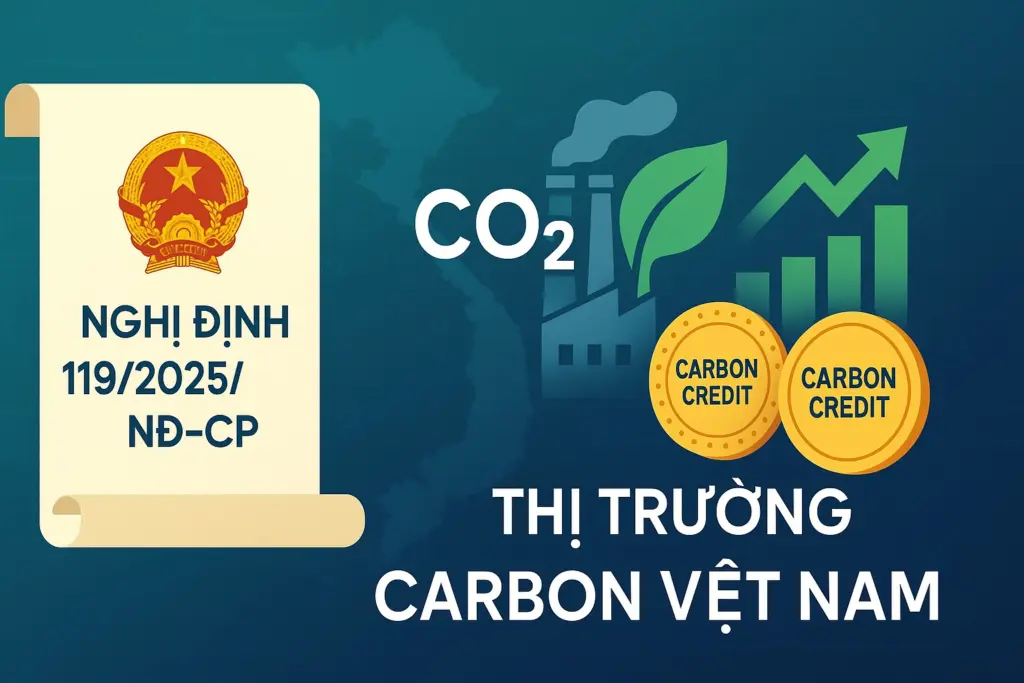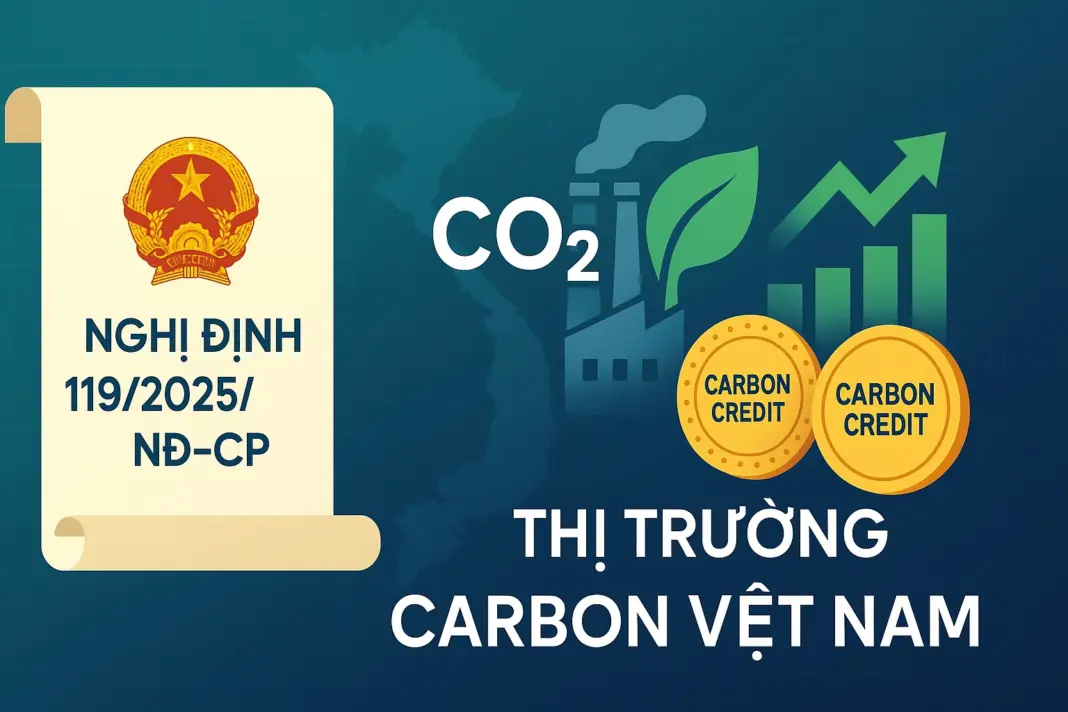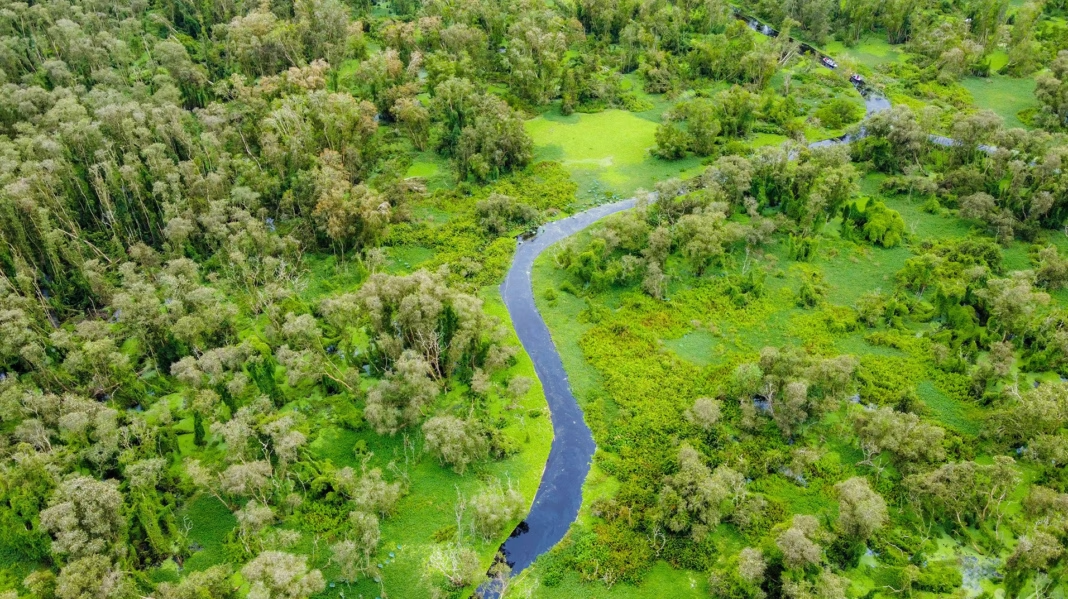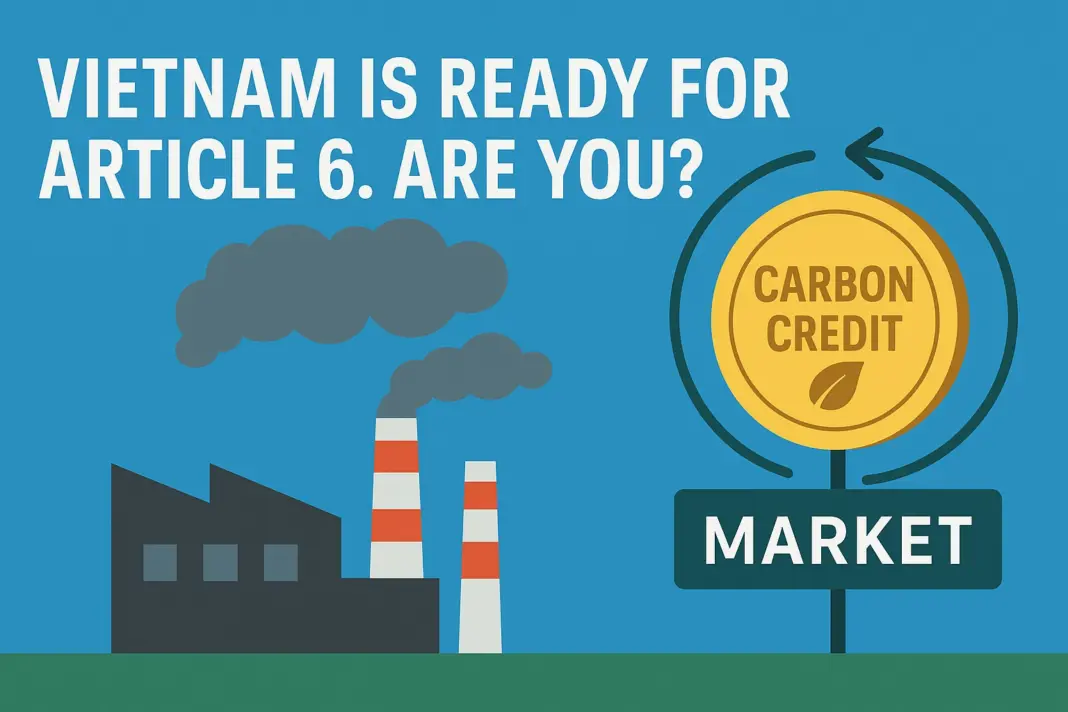The Government of Vietnam has just issued Decree 119/2025/ND-CP dated 9 June 2025, amending Decree 06/2022/ND-CP on greenhouse-gas (GHG) emission reduction and ozone-layer protection. This move tightens the responsibilities of emitting facilities and provides a legal corridor for operating the carbon market in Vietnam.
Thị trường Carbon takes a look at the main changes in Decree 119 and analyses the impacts that businesses need to understand—especially in the energy, agriculture, forestry and heavy-industry sectors. The carbon market and carbon credits are the two core themes, reflecting Vietnam’s determination to pursue sustainable development and align with global trends.

Expanded Scope of Application and Key New Definitions
Decree 119 significantly expands its scope and introduces many new definitions relating to the carbon market. Specifically, the decree now applies to all organisations and individuals involved in activities of emitting, mitigating or absorbing GHGs; organising and developing the carbon market; and implementing domestic and international credit-trading and offsetting mechanisms. This means major emitters, companies participating in the carbon market, and even facilities producing or using ozone-depleting substances all fall under its purview.
The decree also adds a series of important legal definitions to clarify carbon-market concepts, including:
-
Paris Agreement Article 6.2 mechanism – the bilateral cooperation mechanism that allows countries to exchange carbon credits (mitigation outcomes) to meet their NDC targets. This is the national-to-national credit-trading framework under paragraph 2 of Article 6 of the Paris Agreement.
-
Paris Agreement Article 6.4 mechanism – an international market mechanism overseen by the UN that lets organisations register projects under UNFCCC-approved methodologies and receive carbon credits after validation. This succeeds the Clean Development Mechanism (CDM) and creates a globally supervised credit market.
-
Carbon exchange – now defined as a centralised trading system for buying and selling GHG-emission allowances and carbon credits. All domestic allowance and credit transactions must pass through this centralised exchange, ensuring transparency and unified management.
-
National registry system for allowances and credits – an IT system that manages the data and accounts of allowance/credit holders, tracking all borrowing, surrendering, transfer and offsetting activity. It will link to the carbon exchange and provide the infrastructure backbone for an efficient carbon market.
-
Domestic carbon-credit methodologies – added to clarify how to calculate the GHG emission reductions or removals of a project relative to a “without-project” baseline. These underpin the volume of credits that domestic mitigation projects (e.g. renewable-energy, energy-saving or afforestation projects) can receive.
These new definitions standardise terminology and align the domestic legal framework with international practice. By incorporating Articles 6.2 and 6.4, Vietnam signals its readiness to participate deeply in the global carbon market.
Carbon-Market Mechanism: Emission Allowances and Carbon Credits
Decree 119 sets up a domestic carbon-market mechanism through an emissions-allowance and carbon-credit system. For the first time, a concrete roadmap for allocating allowances is laid out in amended Article 12.
-
2025–26 phase: Large emitters in power generation, iron and steel, and cement—already on the mandatory GHG-inventory list—will be given specific allowance allocations. The Ministry of Agriculture & Environment (the focal agency) will coordinate with the Ministry of Industry & Trade and the Ministry of Construction to draft the allocation plan for each facility and submit it to the Prime Minister for approval by 31 December 2025. This ensures that from 2025 the highest-emitting sectors operate under a controlled emissions “cap”.
-
2027–28 and 2029–30 phases: Coverage is widened and allowances refined. Sectoral ministries will propose the list of facilities and annual allowance volumes, sending them to the focal ministry by 30 June of the first year of each phase. The national cap will then be approved by the Prime Minister and distributed to facilities by 31 October of that first year—creating a regular cycle that lets businesses plan mid-term emission reductions or credit purchases.
Allowance-setting uses multiple technical and economic factors. The decree states each facility’s allowance will be calculated on the basis of emission intensity per unit of product, sectoral growth targets, sector/facility mitigation targets, mitigation potential and the facility’s technological and financial capacity. A detailed formula is issued in an annex. This multi-criteria approach aims to ensure fair, feasible allocation and encourage technological upgrading.
An emission allowance represents the right to emit a certain amount of GHGs. Decree 119 defines one allowance unit as the right to emit 1 tonne of CO₂ or 1 tonne of CO₂-equivalent. Facilities may use their allowances for compliant emissions or trade surplus allowances on the carbon market; if short, they must buy extra allowances or credits.
Alongside allowances, carbon credits are units granted for verified GHG reductions (typically 1 tonne of CO₂ avoided). Decree 119 recognises credits generated from programmes or projects that reduce emissions from 1 January 2021 onward under both domestic (Article 20) and international (Article 20a) mechanisms. Crucially, older projects such as CDM or voluntary-market projects can convert post-2021 reductions into credits tradable on Vietnam’s market.
Allowance and credit trading will take place centrally on the national carbon exchange, ensuring state-supervised, transparent transactions and preventing “phantom” credits or fraud.
Surrendering allowances and offsetting – a key novelty is the obligation for facilities to surrender allowances at the end of each allocation period. A facility must return to the state at least the quantity equal to its actual emissions minus any offsets it has retired, via the national registry by 31 December of the year after the allocation period. Surplus surrender is encouraged; deficits trigger penalties and a deduction from the next-phase allocation.
Banking flexibility – until 2030, unused allowances (after surrender) may be carried into the next phase and traded, provided surrender obligations were met. Thirty days after the surrender deadline, any leftover allowances not transferred will be cancelled.
In short, the allowance-and-credit system lets efficient emitters profit from surplus sales while hard-to-abate emitters can purchase compliance units—laying the foundation for an operational carbon market.
Operating the Carbon Market: From Domestic Exchange to Global Linkage
To run the market smoothly, Decree 119 clarifies market organisation, trading infrastructure and international participation.
-
Domestic carbon exchange: The Ministry of Finance will lead in designing and establishing the exchange and related financial policies. Once formed, the Ministry of Agriculture & Environment will operate it, in coordination with other agencies, while provincial authorities help promote market development and public awareness.
-
National registry: The same ministry will build and manage the registry, ensuring data connectivity with the exchange. Every participant will have an account recording all allowance- and credit-related transactions, acting as a central carbon ledger to prevent double-counting.
Market participants are broadened:
-
Allowance traders – facilities allocated allowances.
-
Credit traders – any organisation in Vietnam may buy or sell carbon credits, boosting liquidity.
-
Transaction-support organisations – financial-service providers (banks, brokerages, carbon funds, consultancies) that act as intermediaries and market makers.
Roadmap: By end-2028 Vietnam will complete the registry, pilot the domestic exchange, run domestic credit-exchange and offset mechanisms, and build capacity. From 2029 the system will launch allowance auctions, refine rules and integrate with global markets—mirroring the national roadmap announced earlier in 2025 to support a net-zero target by 2050.
Connecting with International Carbon Markets (Articles 6.2 & 6.4)
A breakthrough is the integration of international mechanisms, enabling cross-border crediting. Added Article 20a on “International carbon-credit exchange and offset” provides that:
-
Article 6.2 participation: Vietnam may sign bilateral or multilateral agreements to exchange credits with partner countries, supporting credit sales or joint projects (e.g. JCM-type schemes).
-
Article 6.4 participation: Domestic entities may register projects under the UN-supervised 6.4 mechanism. The focal ministry will receive dossiers, evaluate and issue Letters of Approval within 30 days. CDM projects may transition to 6.4 if they apply by 30 September 2025.
-
Other international mechanisms: Participation in other international crediting schemes (e.g. voluntary markets, regional systems, CORSIA) is also allowed, subject to each scheme’s rules.
To protect Vietnam’s NDC, any transfer of credits abroad requires approval:
-
For 6.2 projects, the focal ministry will issue written consent within five working days of a project owner’s request.
-
For publicly funded projects outside 6.2, the project owner must obtain comments from relevant ministries and secure approval from the focal ministry before exporting credits. Without this approval, the reductions may only serve Vietnam’s NDC and not another country’s, preventing double counting.
With Decree 119, Vietnam stands ready to link its domestic market with the world, allowing local businesses to access international carbon finance while safeguarding national climate commitments.
Download the full version here: Nghi dinh so 119.
Thị trường Carbon







